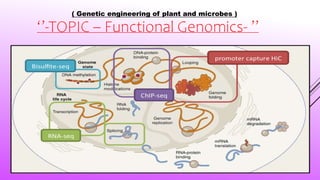
Functional Genomic l Genomes l proteomic l DNA l #genomics #proteomics #science #shortnotes
- 1. ( Genetic engineering of plant and microbes ) ‘’-TOPIC – Functional Genomics- ’’
- 2. SYNOPSIS :- What is genomics Functional genomics Functional genomics in plants Types of functional genomics •Genotyping • Transcription profiling •Epigenetic profiling •Nucleic acid-protein interactions •Meta-analysis Conclusion Reference
- 3. What is genomics Genomics is the study of whole genomes of organisms, and incorporates elements from genetics. Genomics uses a combination of recombinant DNA, DNA sequencing methods, and bioinformatics to sequence, assemble, and analyze the structure and function of genomes. The field of genomics comprises of two main areas:- 1. Structural genomics 2. Functional genomics
- 4. functional genomics functional genomics is the study of how genes and intragenic regions of the genome contribute to different biological processes. A researcher in this field typically studies genes or regions on a “genome- wide” scale (i.e. all or multiple genes/regions at the same time), with the hope of narrowing them down to a list of candidate genes or regions to analyze in more detail. The goal of functional genomics is to determine how the individual components of a biological system work together to produce a particular phenotype. Functional genomics focuses on the dynamic expression of gene products in a specific context, for example, at a specific developmental stage or during a disease. In functional genomics, we try to use our current knowledge of gene function to develop a model linking genotype to phenotype. There are several specific functional genomics approaches depending on what we are focused on ;- •DNA level (genomics and epigenomics) •RNA level (transcriptomics) •Protein level (proteomics) •Metabolite level (metabolomics)
- 6. functional genomics in plants Functional genomics (in combination with other approaches) plays an important role in plant sciences. It is being used in many diverse ways from :- informing selective breeding in tomatoes. producing alternative gluten-free grains (and beer). understanding the response of plants to climate change . Translating findings from one species to another is an important aspect of plant functional genomics and it has just become easier with the development of the Gramene database. Through its two main frameworks, genomes (collaboration with Ensembl Plants) and pathways (Plant Reactome), Gramene provides online resources for visualising and comparing plant genomes and biological pathways As of May 2020, the current release of Gramene contains 67 reference genomes including: rice, maize, wheat, barley, soybean, Arabidopsis, Brassicas, poplar, medicago, tomato, potato, banana, cocoa, peach, grapevine, Amborella, spike moss and algae. In addition to curated rice pathways, Plant Reactome incorporates pathway projections to 97 plant species, including two wild peanut ancestors and the common bean.
- 7. Types in functional genomics Functional genomics experiments measure changes in the DNA (genome and epigenomics), RNA (transcriptome), or interactions between DNA/RNA and proteins that influence the phenotype of a sample.Common branches of functional genomics include: • Genotyping •Transcription profiling • Epigenetic profiling • Nucleic acid-protein interactions • Meta-analysis
- 8. 1.Transcription profiling This is one of the most popular study types, also known as ‘expression profiling’. It involves the quantification of gene expression of many genes in cells or tissue samples at the transcription (RNA) level. Quantification can be done by collecting biological samples and extracting RNA (in most cases, total RNA) following a treatment or at fixed time-points in a time-series, thereby creating ‘snap- shots’ of expression patterns. For common reference genomes with well-annotated transcripts and genes (e.g. the human genome), a researcher can choose to focus on quantifying transcription of all or a subset of transcripts, genes, coding exons, non-coding RNA, and so forth.
- 9. 2. Genotyping Genotyping studies are those which identify differences in the DNA sequence (i.e genotype) of a sample.The genomic DNA samples are often obtained from two contrasting groups of samples, e.g. drought-resistant rice cultivars vs. drought-sensitive counterparts, with the aim of identifying differences in the genotype which may explain the difference in phenotype. Genotyping studies can be designed to identify DNA sequence differences at three levels: •Single nucleotide polymorphisms (SNPs, pronounced ‘snips’): SNP analysis focuses on differences in the DNA sequence at the single nucleotide level. •Copy number variations (CNVs): CNVs refer to an increase or decrease in the number of copies of a segment of DNA (e.g. a gene, or a locus-specific DNA repeat element). Each ‘copy’ can be as short as 50 bases or up to 100 kilobases. •Structural variations: they are an order of magnitude larger than CNVs and often cover megabases of DNA, and can be caused by chromosomal rearrangement events.
- 10. 3. Epigenetic profiling Epigenetics is the study of how biochemical modifications or physical interaction of DNA/chromatin affect gene regulation in a cell, where such modifications/interactions are not related to changes in the underlying DNA sequence. At the DNA level, methylation of CpG dinucleotides (often located near gene promoters) can be detected by first converting unmethylated cytosines into uracil using bisulfite, which allows methylated and unmethylated cytosines to be distinguished. At the chromatin level, modifications of the tails of histone proteins (e.g. methylation, acetylation) can be mapped by ‘immunoprecipitation’, where chromatin and proteins are chemically cross- linked reversibly.The genomic DNA associated with the modification/protein of interest is then ‘pulled-down’ (precipitated) with specific antibodies raised against the modification/protein.After precipitation, the cross-linking is reversed to release the genomic DNA for further analysis.
- 11. 4. DNA/RNA-protein interactions Transcription factors, ribosomes and other DNA/RNA-binding proteins can bind to nucleic acid sequences and influence the transcription and translation of genes.The immunoprecipitation technique has also been applied to study protein binding sites on RNA. 5. Meta-analysis Meta-analysis is a branch of functional genomics in which data from pre-existing experiments is combined to create statistically more powerful models of a biological process.This type of analysis has become popular as it allows the identification of subtle events that could not be detected in smaller studies.